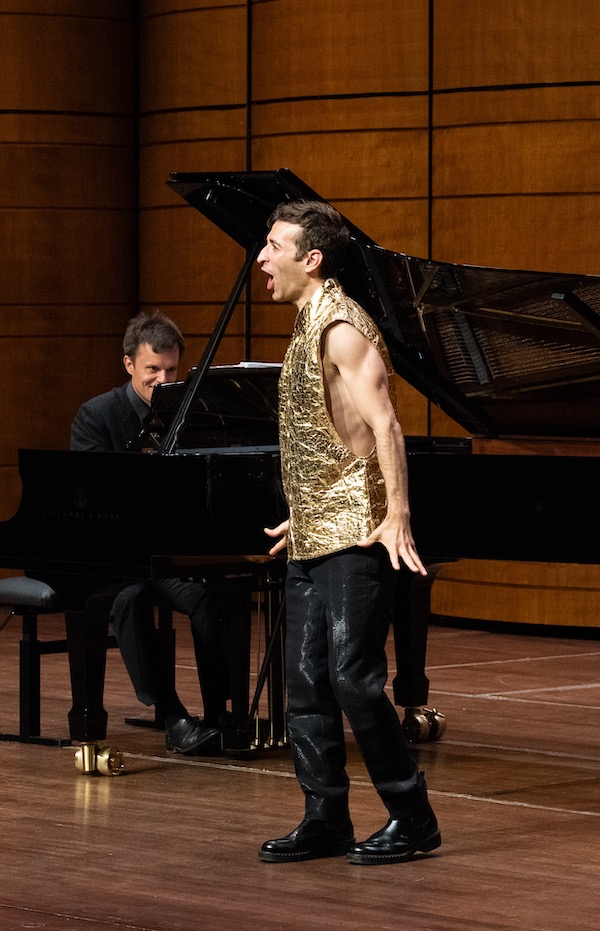Costanzo’s freewheeling program opens Vocal Arts season with mixed rewards

Anthony Roth Costanzo and pianist Bryan Wagorn performed a recital for Vocal Arts DC Thursday night at the Kennedy Center Terrace Theater. Photo: Courtney Ruckman
Even serious concert presenters like Vocal Arts DC can branch out occasionally. The group’s season opener Thursday night, featuring countertenor Anthony Roth Costanzo in the Kennedy Center Terrace Theater, had enough inter-performance narration for a lecture-recital.
At times this was entertaining, as Costanzo channeled the story-telling style of humorist David Sedaris. A peppering of vulgar expressions, even in the introduction by Vocal Arts DC general director Peter Russell, revealed an organization letting its proverbial hair down.
Parts of the programming, regrettably too few, seemed right for a countertenor, a voice type heard only four times in Vocal Arts DC history. The opening set, arias from operas and a cantata by Antonio Vivaldi, suited best, especially the opener, “Gelido in ogni vena” from Farnace. Costanzo possesses a broad range, from baritone depths to extreme, occasionally shrill heights. The shifting between registers sometimes felt labored, but the expression and musical sensitivity impressed.
Pianist Bryan Wagorn went similarly overboard in his rendition of the orchestral reduction of this aria, which opens with material self-borrowed from the “Winter” Concerto of The Four Seasons. Walloped bass notes, held over by the sustaining pedal, undergirded descending scalar figures, and both singer and pianist introduced diverting changes on the da capo repeat. The other Vivaldi selections felt more flat and too much of the same.
Some signs of vocal strain surfaced in “Sento in seno” from Il Giustino, affecting intonation and the beauty of tone. In the only fast aria, “Qual dopo lampi e turbini,” a storm aria from a cantata, Costanzo’s runs turned soggy, and the forays into the higher range paled in “Vedrò con mio diletto,” which rounded out this long Vivaldi set.
The only other piece expressly meant for countertenor was “The Places We Leave,” composed for Costanzo by Joel Thompson, to words by Tracy K. Smith, former poet laureate of the United States. Words and music proved somewhat saccharine and drawn out, and both Wagorn and Costanzo overplayed the introspective aspects of this overlong piece.
Gabriela Lena Frank wrote her marvelous song cycle Cantos de Cifar y el Mar Dulce for baritone, although the composer herself has revised the work for other combinations. Frank’s writing crossed often into female territory, as a way to indicate the semi-mythological nature of the narrator, the sailor Cifar, based on the life of the poet, Pablo Antonio Cuadra. Costanzo’s incarnation of three of these songs reversed that idea, a mainly treble singing voice that occasionally burst out in baritonal anger.
Costanzo excelled in the tense recitative of “El Rebelde,” with a clever eye for dramatic heightening through phrasing and diction. Wagorn’s tempestuous piano part upstaged the countertenor in the raging middle song, “Eufemia,” while both artists communicated the stark sadness of the final song, “En la vela del angelito,” about a shipwreck that left no survivors.
The selections on the second half were even more of a stretch, with less successful results. It led off with four songs by Giuseppe Verdi. Both men and women have sung all of these songs, which were not intended for one particular voice part. Costanzo described this as his first time singing Verdi in public, and he brought the same vocal intensity—not sure one can quite say “squillo” with the countertenor sound—and expression to them.
Yet as Verdi moved into the high range of these songs, including three selections from his first set of six Romanze, Costanzo’s somewhat squeezed top could not provide sufficient emotional weight. The grain in the voice, a signifier of emotional pain, was especially lacking in the middle section of “Non t’accostare all’urna,” and the roller-coaster of “Stornello” might have worked better in a slightly lower key.
At least Costanzo admitted that he has “no business singing” Desdemona’s “Ave Maria” from Verdi’s Otello. Without the orchestral score’s halo of lush strings, it’s hardly worth it anyway. The countertenor pulled off the concluding high note, but much of the piece felt like a poor fit.
With a closing set of pop songs, made even more popular by Barbra Streisand, Costanzo went from stretch to kitsch. Some in the audience headed for the doors, but others seemed enchanted. An absurd encore raised the camp factor even more: in “Crudel! Perchè finora,” the Act III duet for the Count and Susanna from Mozart’s Le Nozze di Figaro, Costanzo sang both parts in their correct ranges, spinning dizzily as he shifted characters.
Tenor Jonah Hoskins and pianist William Woodard perform songs by Heggie, Satie, Hoiby, Robert Schumann, and Schubert 7:30 p.m. December 13. vocalartsdc.org






